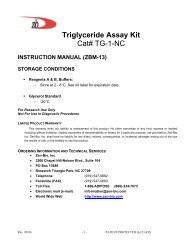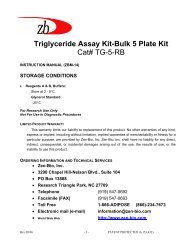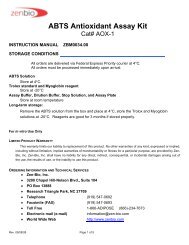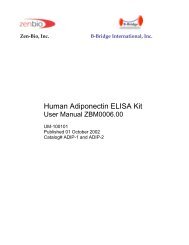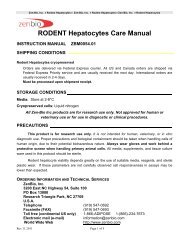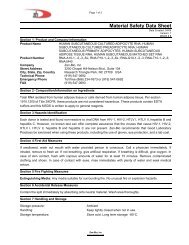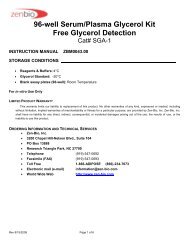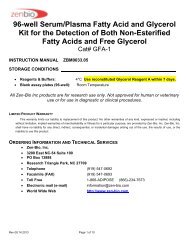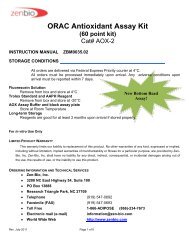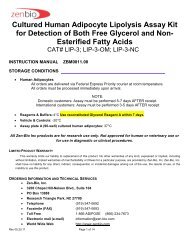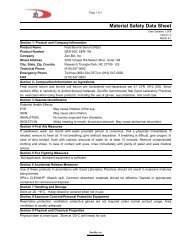ABTS Antioxidant Assay Kit (AOX-1) (pdf) - Zen-Bio Inc.
ABTS Antioxidant Assay Kit (AOX-1) (pdf) - Zen-Bio Inc.
ABTS Antioxidant Assay Kit (AOX-1) (pdf) - Zen-Bio Inc.
You also want an ePaper? Increase the reach of your titles
YUMPU automatically turns print PDFs into web optimized ePapers that Google loves.
<strong>ABTS</strong> <strong>Antioxidant</strong> <strong>Assay</strong> <strong>Kit</strong>Cat# <strong>AOX</strong>-1INSTRUCTION MANUALZBM0034.03STORAGE CONDITIONS<strong>ABTS</strong> SolutionAll orders are delivered via Federal Express Priority courier at 4°C.All orders must be processed immediately upon arrival.Store at 4C.Trolox standard and Myoglobin reagentStore at -20°C<strong>Assay</strong> Buffer, Dilution Buffer, Stop Solution, and <strong>Assay</strong> PlateStore at room temperatureLong-term storage:Remove the <strong>ABTS</strong> solution from the box and place at 4°C, store the Trolox and Myoglobinsolutions at -20°C. Reagents are good for at least 3 months after arrival if stored properly.For in vitro Use OnlyLIMITED PRODUCT WARRANTYThis warranty limits our liability to replacement of this product. No other warranties of any kind, expressed or implied,including without limitation, implied warranties of merchantability or fitness for a particular purpose, are provided by <strong>Zen</strong>-<strong>Bio</strong>, <strong>Inc</strong>. <strong>Zen</strong>-<strong>Bio</strong>, <strong>Inc</strong>. shall have no liability for any direct, indirect, consequential, or incidental damages arising out ofthe use, the results of use, or the inability to use this product.ORDERING INFORMATION AND TECHNICAL SERVICES <strong>Zen</strong>-<strong>Bio</strong>, <strong>Inc</strong>. 3200 Chapel Hill-Nelson Blvd., Suite 104 PO Box 13888 Research Triangle Park, NC 27709 Telephone (919) 547-0692 Facsimile (FAX) (919) 547-0693 Toll Free 1-866-ADIPOSE (866)-234-7673 Electronic mail (e-mail) information@zen-bio.com World Wide Web http://www.zenbio.comRev. Dec.2010 Page 1 of 11
TABLE OF CONTENTSPAGE#Introduction 3Principle of <strong>Assay</strong> 4Items <strong>Inc</strong>luded in the <strong>Kit</strong> 4Sample Preparation 5<strong>Assay</strong> Procedure 6Trolox Standard Curve 7Appendix : Plate layout 10Appendix B: Protocol Flowchart 11References 11Rev. Dec.2010 Page 2 of 11
INTRODUCTIONFree radicals and reactive oxygen species (ROS) are highly reactive molecules that aregenerated by normal cellular processes, environmental stresses, and UV irradiation. ROS reactwith cellular components, damaging DNA, carbohydrates, proteins, and lipids causing cellular andtissue injury. Excess production of reactive oxygen species can also lead to inflammation,premature aging disorders, and several disease states, including cancer, diabetes, andatherosclerosis. Organisms have developed complex antioxidant systems to protect themselvesfrom oxidative stress, however, excess ROS can overwhelm the systems and cause severedamage.The <strong>Zen</strong>-<strong>Bio</strong> <strong>ABTS</strong> <strong>Antioxidant</strong> <strong>Assay</strong> <strong>Kit</strong> can be used to determine the total antioxidantcapacity of biological fluids, cells, and tissue. It can also be used to assay the antioxidant activity ofnaturally occurring or synthetic compounds for use as dietary supplements, topical protection, andtherapeutics. The assay measures <strong>ABTS</strong> .+ radical cation formation induced by metmyoglobin andhydrogen peroxide. Trolox [6-Hydroxy-2,5,7,8-tetramethylchroman-2-carboxylic acid], a watersoluble vitamin E analog, serves as a positive control inhibiting the formation of the radical cation ina dose dependent manner. The antioxidant activity in biological fluids, cells, tissues, and naturalextracts can be normalized to equivalent Trolox units to quantify the composite antioxidant activitypresent. This assay measures radical scavenging by electron donation and when combined with<strong>Zen</strong>-<strong>Bio</strong>’s ORAC antioxidant assay kit, provides a comprehensive analysis of a test sample’santioxidant activity.0.7<strong>ABTS</strong> <strong>Assay</strong>0.60.5TroloxL-AscEGCGGallicAbsorbance 405 nm0.40.30.20.100 50 100 150 200 250 300 350Rev. Dec.2010 Page 3 of 11Concentration (mM)Figure 1. Effects of antioxidants in <strong>ABTS</strong> assayTrolox, Sodium L-ascorbate (L-Asc), Epigallocatechin gallate (EGCG), and Gallic acid (Gallic) were testedfor their antioxidant activity in the <strong>ABTS</strong> antioxidant assay.
SAMPLE PREPARATIONCell Lysate Preparation1. Scrape ~1 x10 6 cells and centrifuge at 1,000xg to prepare a cell pellet. DO NOT use proteolyticenzymes such as trypsin but scrape using a rubber policeman or cell scraper tool.2. Homogenize or sonicate the cell pellet on ice in 1ml cold <strong>AOX</strong> <strong>Assay</strong> buffer3. Centrifuge at 10,000 x g for 15 minutes at 4C.4. Remove the supernatant and keep on ice until ready to use in the assay.5. If not using the same day, store the samples at -80C.6. Data is expressed as Trolox equivalents (TE) per cell number(i.e. µmole TE/10 6 cells)Tissue Lysate Preparation1. Homogenize tissue samples on ice in cold buffer at ~200mg tissue per ml cold buffer2. Centrifuge at 10,000 x g for 15 minutes at 4C.3. Remove the supernatant and keep on ice until ready to use in the assay.4. If not using the same day, store the samples in small aliquots at -80C.5. Data is expressed as Trolox equivalents (TE) per gram of starting sample(i.e. µM TE/g)Plasma Preparation1. Collect the blood in a tube containing heparin or other anticoagulant.2. Centrifuge at 1,000 x g for 10 minutes at 4C.3. Remove the supernatant and keep on ice until ready to use in the assay.4. If not using the same day, store the samples in small aliquots at -80C.5. Data is expressed as micromoles Trolox equivalents (TE) per volume sample (i.e. µmole TE/L)Serum Preparation1. Collect the blood in a tube WITHOUT any anticoagulant. Allow the blood to clot.2. Centrifuge at 2,000 x g for 10 minutes at 4C.3. Remove the supernatant and keep on ice until ready to use in the assay.4. If not using the same day, store the samples in small aliquots at -80C.5. Data is expressed as micromoles Trolox equivalents (TE) per volume sample(i.e. µmole TE/L)Saliva Collection1. Collect whole saliva for a defined period of time (i.e. 1-5 minutes) into polypropylene tubes.2. Immediately place on ice or store at -80C for later analysis.3. Data is expressed as micromoles Trolox equivalents (TE) per volume sample (i.e. µmole TE/L)Food Extract Preparation1. Weigh the starting material.2. Homogenize in a small volume ice cold buffer or water.3. Store small aliquots at -80C for analysis.4. When ready to assay, keep thawed samples on ice.5. Data is expressed as Trolox equivalents (TE) per gram of starting sample (i.e. µM TE/g)Rev. Dec.2010 Page 5 of 11
TROLOX STANDARD CURVE.Generate standard curve: see example below[DO NOT use this standard curve to generate your data. This is an example.]M Trolox OD stdev0 0.871 0.0194.6875 0.864 0.0069.375 0.855 0.00318.75 0.829 0.01837.5 0.806 0.00675 0.742 0.013150 0.636 0.009300 0.436 0.013slope = -0.0015intercept= 0.8629R 2 = 0.9969Absorbance 405 nm10.90.80.70.60.50.40.30.20.10Standard Curvey = -0.0015x + 0.8629R² = 0.99690 50 100 150 200 250 300mM Troloxy = observed O.D.x = concentration of Trolox in MTo calculate x for each y, (i.e. to change the observed O.D. into Trolox equivalent concentration) use thefollowing equation:y=(slope) times (x) plus intercepty=mx+b so x=(y-b)/mx=(y – 0.8629)/(-.0015) where (-.0015)= slope of the line and 0.8629= y intercept. Be careful to enter theproper sign for the y intercept value as it may be a negative number.The R 2 value should be equal or greater then 0.98 for the standard curve to be valid. Any R 2values below 0.98, must have the standard curve run again.<strong>Antioxidant</strong> activity is expressed as M Trolox equivalents (TE).Rev. Dec.2010 Page 7 of 11
OPTIONAL KINETIC ASSAY PROCEDURE1. Prepare Trolox and myoglobin reagents as described above.2. Set-up plate reader for kinetic reading mode:Total time = 10 minutesInterval = 30 secondsAbsorbance= 405nm3. Add 10 l of samples or Trolox standards to individual wells of the assay plate provided, add 10l of assay buffer to individual wells as a negative control.4. Add 20 l of the myoglobin working solution to each of the wells containing standards andsamples from step 3.5. To begin the assay, add 100 l of the <strong>ABTS</strong> solution per well and place in plate reader and beginreading absorbance using the kinetic mode.TROLOX KINETIC STANDARD CURVETime (min.)Trolox concentration (M)1500 750 375 187.5 93.75 46.875 23.4375 00 0.059 0.058667 0.060333 0.062 0.059667 0.080333 0.109333 0.1420.5 0.055667 0.056 0.058 0.059333 0.102667 0.159333 0.189667 0.2193331 0.055667 0.056333 0.057333 0.076333 0.183333 0.238667 0.268667 0.31.5 0.055667 0.055667 0.057667 0.154667 0.262 0.318333 0.35 0.3813332 0.055333 0.055667 0.058 0.233667 0.341667 0.398 0.431333 0.4632.5 0.056 0.056333 0.098333 0.314333 0.422667 0.478333 0.512667 0.5453 0.056333 0.056667 0.175667 0.394667 0.503 0.558 0.592667 0.6253333.5 0.056 0.056333 0.252 0.474 0.582 0.636667 0.672 0.7044 0.056667 0.056667 0.328667 0.554333 0.662 0.715333 0.751333 0.7834.5 0.057 0.057 0.405667 0.634667 0.742 0.794 0.830667 0.8623335 0.056333 0.056667 0.483 0.715333 0.820667 0.871333 0.909333 0.9413335.5 0.056667 0.077667 0.563333 0.797667 0.900667 0.95 0.99 1.0246 0.057333 0.154333 0.645 0.881333 0.981 1.032333 1.072 1.1096.5 0.057333 0.233667 0.729 0.966667 1.063 1.116333 1.155667 1.1967 0.057 0.313333 0.813 1.053 1.145333 1.201667 1.240667 1.2837.5 0.057333 0.396667 0.899333 1.142333 1.230667 1.29 1.328 1.3723338 0.058 0.481667 0.987667 1.233333 1.319333 1.380333 1.417667 1.4626678.5 0.058333 0.567667 1.075667 1.325667 1.408667 1.470333 1.507333 1.5539 0.058333 0.654667 1.164667 1.419 1.500333 1.562667 1.599 1.6449.5 0.059 0.743 1.254667 1.512667 1.594333 1.656333 1.692 1.73633310 0.059333 0.832333 1.346667 1.608 1.690667 1.751333 1.785667 1.829333AUC1500 1.668667750 5.160833375 11.34033187.5 15.30993.75 17.1703346.875 18.28423.4375 19.012830 19.76167Area under the curve (AUC)AUC= 0.5+ f0+f1+...+f20+(0.5*f21)Where fx = Abs value at time points 0 – 10 minRev. Dec.2010 Page 8 of 11
Figure 2. Absorbance over time for Trolox standards21.81.6Absorbance 405 nm1.41.210.80.60.40.20375187.593.7546.87523.437500 2 4 6 8 10 12Time (minutes)Figure 3. AUC values for increasing Trolox concentrations2520AUC15105AUC00 100 200 300 400Concentration (mM)Comparison of Stopped and Kinetic <strong>Assay</strong>sFigure 4. <strong>ABTS</strong> Absorbance Values at 5 Minutes0.70.60.52520Figure 5. AUC Values for Kinetic <strong>Assay</strong>0.40.3TroloxL-AscEGCG1510TroloxL-AscEGCG0.20.1Gallic5Gallic000 100 200 300 4000 100 200 300 400Trolox =Trolox [6-Hydroxy-2,5,7,8-tetramethylchroman-2-carboxylic acid]L-Asc = Sodium L-ascorbateEGCG = Epigallocatechin gallateGallic= Gallic acidRev. Dec.2010 Page 9 of 11
APPENDIX A: Plate layout.ABCDEFGH1 2 3 4 5 6 7 8 9 10 11 12Rev. Dec.2010 Page 10 of 11
APPENDIX B: Protocol Flowchart<strong>ABTS</strong> ASSAYMake necessary test compounddilutions in <strong>Assay</strong> Buffer.Prior to assay, allow <strong>ABTS</strong> solution toequilibrate to room temperature, preparemyoglobin dilution and standards.Keep Trolox and myoglobin solutions onice until used.Add 10 l/well samples or standards toblank assay plate.PlateOOOOOOOOOOOOOOOOOOOOOOOOOOOOOOOOOOOOOOOOOOOOOOOOOOOOOOOOOOOOAdd 10 l samplesor standardsAdd 20 l/well myoglobin dilution to the plate(including the Trolox standards).PlateOOOOOOOOOOOOOOOOOOOOOOOOOOOOOOOOOOOOOOOOOOOOOOOOOOOOOOOOOOOOAdd 20 lmyoglobin solutionStart assay by adding 100 l/well <strong>ABTS</strong> solution.<strong>Inc</strong>ubate at 25 o C (room temperature) for 5minutes and stop reaction by adding 50l/well stop solution.Optionally, perform kinetic assay byplacing in plate reader and measureabsorbance at 405 nm every 30 secondsfor 10 minutes.PlateOOOOOOOOOOOOOOOOOOOOOOOOOOOOOOOOOOOOOOOOOOOOOOOOOOOOOOOOOOOOPlateOOOOOOOOOOOOOOOOOOOOOOOOOOOOOOOOOOOOOOOOOOOOOOOOOOOOOOOOOOOOAdd 100 l <strong>ABTS</strong>solutionAdd 50 l STOPsolutionStopped <strong>Assay</strong>: Measure the opticaldensity of each well at 405 nm usinga spectrophotometer plate reader.REFERENCES1. Clin. Chem., 44(6):1309–1315, 1998.2. J. Clin. <strong>Bio</strong>chem. Nutr., 44: 46–51, January 2009.3. Indian J <strong>Bio</strong>chem & <strong>Bio</strong>phy. 46, 126-129 February 2009.Rev. Dec.2010 Page 11 of 11



